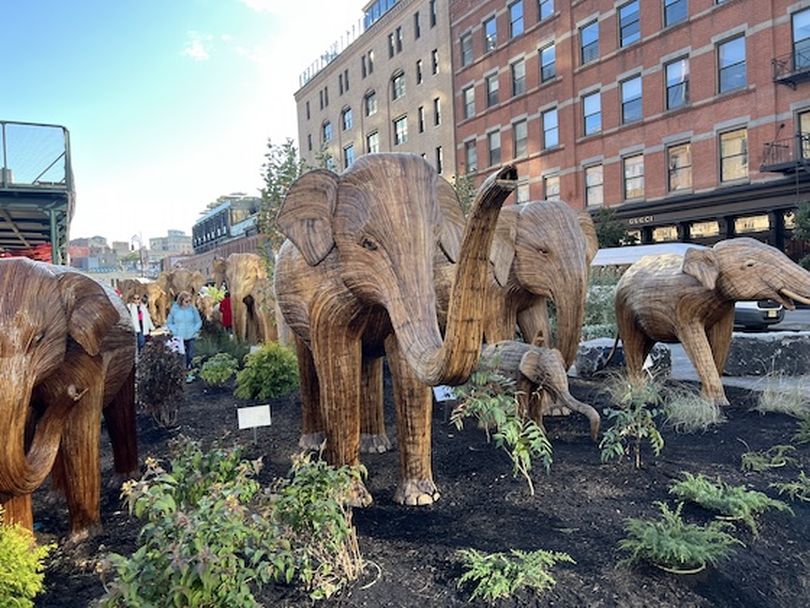New York City: a world all its own

You don’t have to search very far to find comments about New York City that capture the place in all its unique, and utterly complex, essence.
Take this quote from the late writer Joan Didion: “New York was no mere city. It was instead an infinitely romantic notion, the mysterious nexus of all love and money and power, the shining and perishable dream itself.”
Or this one from the late painter Georgia O’Keeffe: “One can't paint New York as it is, but rather as it is felt.”
In one way or another both sentiments express well what I’ve experienced during the numerous visits I have made to the city over the past three decades. My most recent visit is a good example.
My wife and I stayed for a couple of nights in Manhattan, in the Executive Hotel Le Soleil, which sits near where our friends Karen and Allen live. Longtime city residents, they know all the interesting places to experience. Here are a few that they guided us to this time around:
The Morgan Library & Museum: Built originally by the financier and investment banker J. Pierpoint Morgan, the library was intended to be a personal repository of Morgan’s many books, papers and other valuables. It’s located right next to what was the man’s own residence, at Madison and 36th Street.
Here’s how the museum describes itself: “Majestic in appearance yet intimate in scale, the structure was to reflect the nature and stature of its holdings. The result was an Italian Renaissance-style palazzo with three magnificent rooms epitomizing America's Age of Elegance.”
Expanded over the years, and in 2006 renovated by the noted Italian architect Renzo Piano, the facility now includes a new café and restaurant, a museum shop and reading room. Amid its collection are three copies of the Gutenberg Bible, a copy of Charles Dickens’ “A Christmas Carol” signed by the author himself, photos by Edward S. Curtis, paintings and journals of artists such as Renoir and Manet and numerous other rare cultural treasures.
One of the most notable aspects of the library involves what occurred in 1924. That was when Morgan’s son, J.P. Morgan Jr., transformed it into a public institution, making it, the museum says, “one of the most momentous cultural gifts in U.S. history.” For some of the privileged class, the notion of noblesse oblige was – at one time – a worthy concept.
New York Botanical Garden: Dating back to 1891, the 250-acre garden is not just a place full of plants of all kinds but also both a scientific workhouse dedicated to safeguarding the environment and a facility that features regular artistic and musical events.
We took the train from Grand Central (where we later ate dinner) and 20 minutes later we were at the garden’s station, just across from its Mosholu Entrance. All-Garden passes run $35 for non-NYC adults ($31 for seniors).
If that seems a bit steep, you do get to see everything the garden has to offer, depending on the season, from the Conifer Arboretum to the Perennial Garden and more. We took the passenger mini-train that tours the entire site, and we were most impressed with the giant pumpkins that were on display pre-Halloween.
Chelsea Market: Originally the site of the National Biscuit Company – otherwise known as Nabisco – the market dates to the 1890s. At that time the trains that traversed the city’s High Line furnished ice blocks to the butchers who worked on the area’s streets below. It was those butchers who supplied Nabisco with lard it needed for baking.
These days, the entire complex – which takes up an entire city block – houses a number of retail outlets on the ground floor. Various businesses, from the Oxygen and Food Networks to most recently Google, fill the office spaces of the upper floors.
One of the most-visited spots in NYC, the market attracts an estimated 6 million visitors a year. And amid all the ground-floor businesses, from the arts and retail shops, you can find 40-plus food outlets. As the market’s website claims, “It’s entirely possible to enter the Market in the morning and not exit until lunchtime, without ever growing bored – and certainly without ever going hungry.”
The Great Elephant Migration: Some of any city’s attractions are transitory, momentary examples of art or cultural commentary, sometimes both at once. We experienced such an attraction, the Great Elephant Migration, on the street outside the Chelsea Market during our mid-October visit.
Designed to draw attention to the problems facing elephants in India, the installation is traveling around the country. One pressing concern is the presence of the invasive weed known as lantana camara, a weed said to be inedible both to humans and animals. Its presence forces animals – such as elephants but also rhinos, tigers and lions – out of their native habitats and into urban areas.
The irony of the traveling exhibit is that each figure, created by a collective of 200 indigenous artisans, is made from lantana camara itself. (The exhibit is scheduled to be set up in Browning, MT, sometime in June.)
Final thoughts: Since I began this post with a quote about New York City, it’s only fitting that I end it with one. Or two.
“New York is a city of possibility and endless exploration” wrote Elizabeth Gilbert, author of “Eat, Pray, Love.” “There’s always something new to discover around every corner.”
Or as Truman Capote once wrote, “New York is not a city, it’s a world.”
